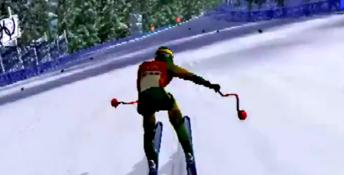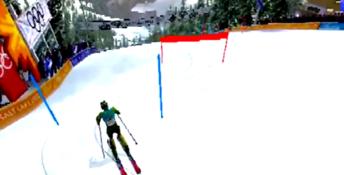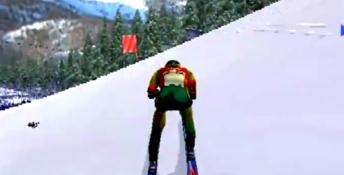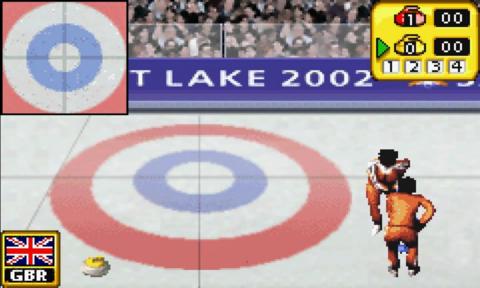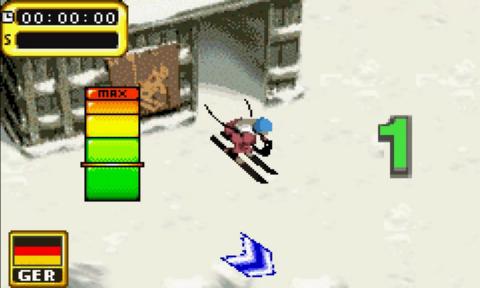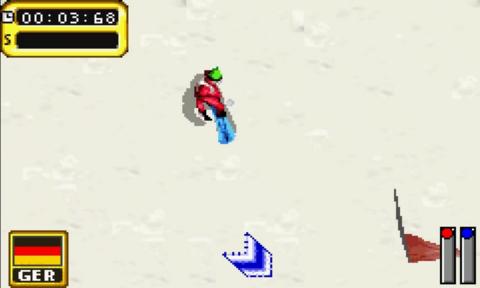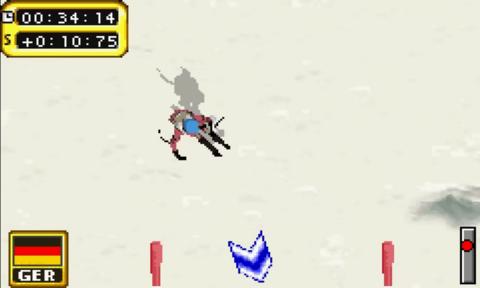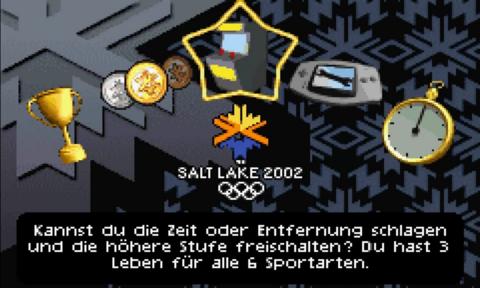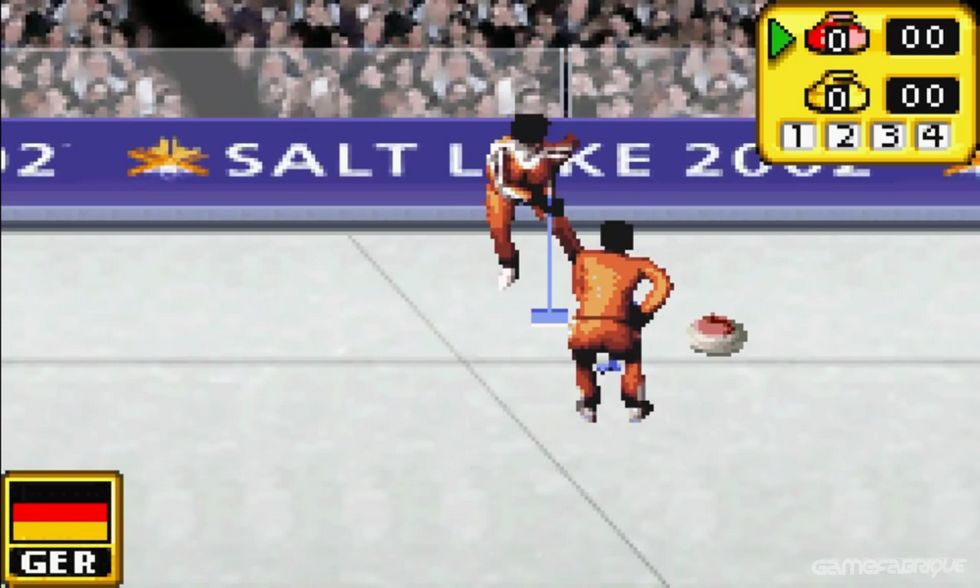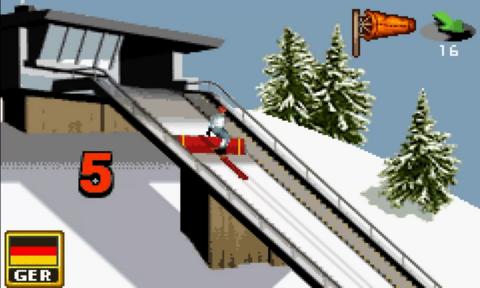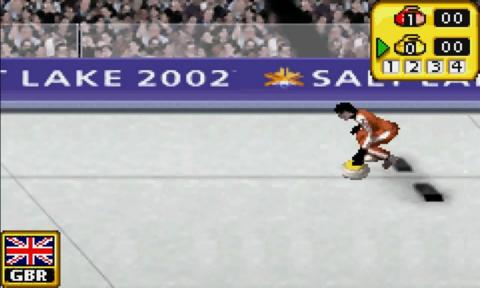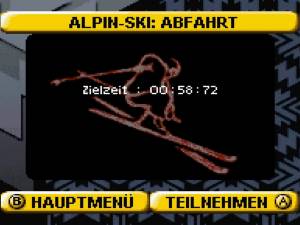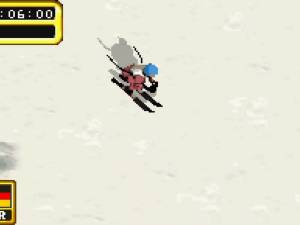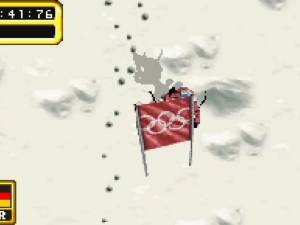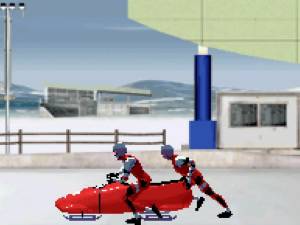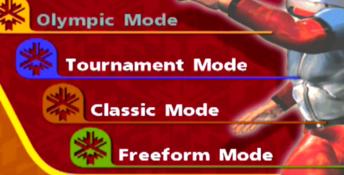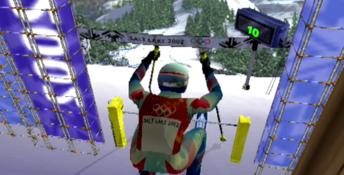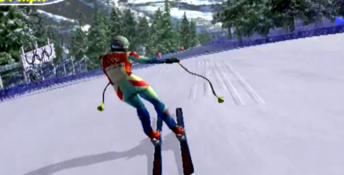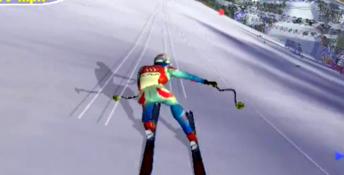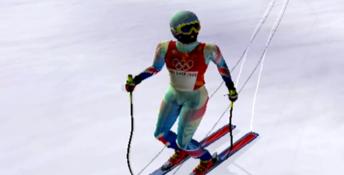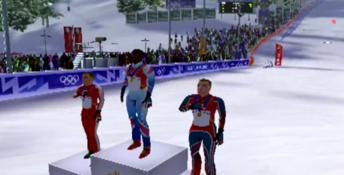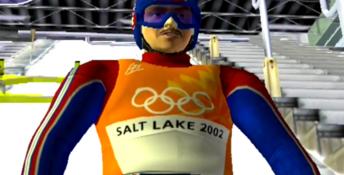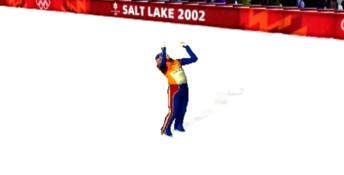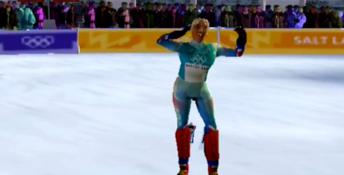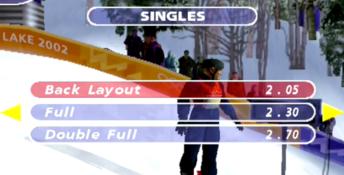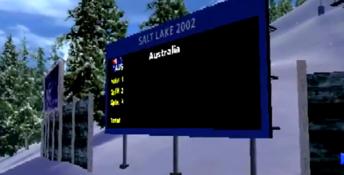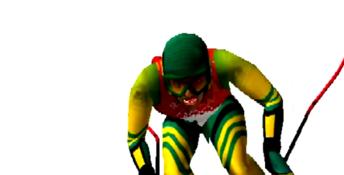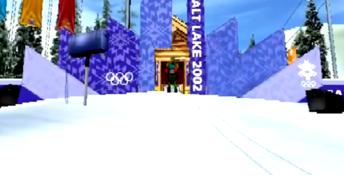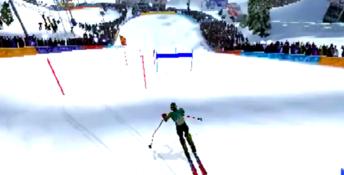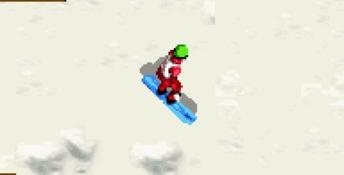Salt Lake 2002
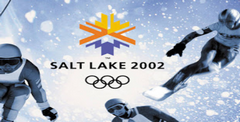
| a game by | Ubisoft |
| Genre: | Sports |
| Platforms: | PC, Playstation 2, GBA |
| Editor Rating: | 7/10, based on 1 review, 3 reviews are shown |
| User Rating: | 8.5/10 - 4 votes |
| Rate this game: | |
| See also: | Winter Sports Games |
As those who read last month’s entertaining and informative preview will be aware, this is of course the official video game of the Olympic Winter Games. Eidos have an exclusive six-year agreement with the International Olympic Committee and they’re going to use it. Following the solid debut of Sydney 2000, the action moves to the considerably colder climes of Salt Lake, home to the games that will be hitting your televisions any time soon. What do you mean, you didn't know? Haven’t you been feverishly counting the days until the action starts? Won’t you be setting your alarm for the heats of the Ladies’ Luge?
Probably not. It is admittedly difficult to get too excited about an event that is mainly screened in the dead of night and which involves people you’ve never heard of doing things you don't understand. And that’s just the Adult Channel. As for the Winter Olympics, it tends to elicit a disinterested shrug from all but the most sport-obsessed insomniacs, particularly as we no longer have the likes of Torvill and Dean to bring home the Gold for Great Britain. Forever in the shadow of the 'proper’ summer Olympics, it doesn’t have quite the same cachet. Like the Worthington Cup compared to the FA Cup, it’s good but it’s not right.
Utah Saints
But we digress. There’s a game that needs reviewing and it features six events culled from the Winter Olympics, all naturally replicated to within a snowflake of the real thing. The latest advances in motion capture and satellite technology have all been utilised to create a game that bears a freak resemblance to the television coverage, with the key difference that you get to press a few buttons while watching it. Back in the day, games were about invention and imagination; nowadays it seems to be enough to simply copy the telly. It’s well done though, and while we can’t vouch for the exact televisual likeness at the time of writing, it does carry all the hallmarks of 'official product,’ from the authentic branding to the BBC commentary team. Ultimately, the action is all that matters though, and it goes like this.
Men's Alpine Skiing Downhill: not bad at all, it involves racing against the clock through a series of gates. Often exceeding 80mph, it manages to convey a reasonable sense of speed, particularly when you become airborne, and is especially terrifying in first-person mode, accompanied by the guttural sounds of your skier breathing.
Men’s Snowboard Parallel Giant Slalom: anyone who has ever graced the slopes will be all too aware of the absurd snobbery that exists between skiers and snowboarders, as if there is a moral superiority in sliding down a frozen mountain on two thin sticks as opposed to a single phat one. Thankfully, boarding has now been accepted as an Olympic sport, as reflected here. It’s pretty basic fare compared to the extravagant snowboarding console games, an inevitable consequence of taking a documentary approach. It’s perfectly playable though, and sees you go head to head with a competitor over two heats, with victory going to the man with the lowest combined time. It can be fairly tense, and if you see your opponent loom into view, it’s time to up the pace, at the risk of missing a gate and being disqualified.
Going For Gold
Ladies’ Alpine Skiing Slalom: a change of pace from the men’s event, this has loads of small gates situated close together, necessitating a 180-degree turn before each one, something that requires rhythm and precision timing. Can be frustrating.
Men’s Ski Jumping K120 Individual: probably the first time such an event has been replicated, and for good reason. Not the most interactive of experiences, it simply involves setting off when the wind drops, pressing a button at take-off, gliding for a bit, straightening your skis and landing. Mildly satisfying if you get it right, but by no means a deal-breaker. I Women’s Freestyle Skiing Aerials: this is possibly even more absurd, this simply requires pressing buttons on command. Get it right and your skier will perform the requisite stunts, although you don’t really see her as you’re concentrating on the instructions at the bottom of the screen. You might as well train a monkey to do it.
Men’s Two-Man Bobsleigh: they didn’t think it could be done, and they were half right. Requires vigorous buttonbashing to pick up speed, timing to jump into the sleigh, and then adroit steering to stay on the racing line without overdoing it and risking decapitation. Perversely playable.
That’s your lot then, and with only six events it does tend to be over quite quickly, although four different game modes do add some variety. It’s undeniably a polished affair, and with a vast leap of imagination you can almost convince yourself that you’re competing for Gold. Or you could just put the telly on.
Download Salt Lake 2002

System requirements:
- PC compatible
- Operating systems: Windows 10/Windows 8/Windows 7/2000/Vista/WinXP

System requirements:
- PC compatible
- Operating systems: Windows 10/Windows 8/Windows 7/2000/Vista/WinXP

System requirements:
- PC compatible
- Operating systems: Windows 10/Windows 8/Windows 7/2000/Vista/WinXP
Game Reviews
It may be more renowned for dubious marital practices and land speed records, but Salt Lake City is hosting the Olympics. Not the proper Olympics, of course, that was Sydney 2000, as replicated in the game of the same name. This is your winter variety, where unpronounceable Scandinavians get sunk up to the nuts in white powder over a series of obscure events. Developers Attention To Detail have had a long hard look at those events, and selected around half a dozen for your delectation. So what are we looking at? Curling? Luge? Nordic Ski? Nope, the six official events are Men's Alpine Skiing Downhill, Women's Alpine Skiing Slalom, Men's Two-man Bobsleigh, Women's Freestyle Skiing Aerials, Men's Ski Jumping K120 Individual and Men's Snowboard Parallel Giant Slalom. Try saying that lot after eight pints.
All six events seem to involve some form of sliding downhill, so what were the criteria for selection? We asked ATD programmers Steve Wilcox and Justin Eames, who replied as one: "Some events transfer into gameplay far better than others. We tried to use the events we thought we could really inject some fun into. The bobsleigh was the one we were worried about but with a bit of effort it's turned out to be one of the best events. It's effectively a mini-racing game - you adjust your line on the course to accelerate and brake so you can find the optimal racing line - plus you've got to make a good start, just like the event in real life!"
But what about ski-jumping, a sport last given major coverage by the risible antics of goggle-eyed buffoon, Eddie "The Eagle" Edwards? How will that translate to a game? Well, according to ATD's programmers: "Ski-jump is all down to timing and making fine adjustments, much as it is in real life.
We injected as much of the "vertigo feel' as we could at the start, so you get a little taster of what it must be like up there preparing for a jump."
Finger Bobs
Of course, Olympics-based games are traditionally associated with hammering the keyboard like a crazed ape, a heritage that stretches back to Daley Thompson's Decathlon, the ruin of many a ZX Spectrum. This rather primitive form of gameplay made up the bulk of Sydney2000, but for Salt Lake 2002, ATD claims: "We've tried to tax the player with more than just button-bashing skills, this time you need quick reflexes, pinpoint timing and good hand-eye co-ordination. Though there is the occasional bit of bashing required to get you off to a good stan in some events so don't put the plasters away just yet."
If you played - or read about -Sydney 2000, you may recall that extreme attention to detail (pun intended) was paid to accurately recreating the various environments, to the extent of taking thousands of digital pictures of the various stadia and so forth. Well, the same process applies to Sall Lake, while the embittered programmers were kept in a darkened room.
"Two members of the an team went over to Salt Lake at the start of development. They took hundreds of pictures and loads of video footage of the courses and the structures while they were being built. Also we had world class athletes from each of the disciplines visit us on site to give us expert consultancy on each event. These celebrities also donned a motion capture suit and provided all the animations for the game. If you play the game and the video side by side it looks remarkably similar, we're really pleased with that!" If anything, they've gone even further this time, as environments have been created using satellite imaging technology, with terrain accurate to two feet in height.
The Olympic licence has also enabled them to model the actual courses and building structure, as well as replicate the television coverage. As ATD say: "We even had the television camera positions and shot sequences so we've based the replay cameras on the son of thing you'll actually see when you watch it on TV. That's all really important when you're trying to get the player to really feel like they are there!"
Dream On
With Salt Lake 2002 featuring snowboarding, it's tempting to bracket it with the slew of extreme sports titles. However, ATD vehemently deny that it's competing with those types of games, screaming: "Not at all! Salt Lake 2002 offers a unique combination of events designed to fully recreate the Olympic atmosphere and competition structure. But this is a game after all, so we used some exciting music to add a degree of adrenaline."
The game will also feature the BBC commentary team of former Olympic Skier Graham Bell, and Stuart Storey, whose voice bears a freak resemblance to Alan Partridge's. But that's the kind of calibre you start to expect from the official game of the Winter Olympics.
As ATD say, "Having the official license has attracted the famous athletes and many other sporting bodies to help us create a game which allows you to live the Olympic Dream..."
We've played. It seems alright.
Overview
Why only watch the Olympics in Salt Lake City on TV when you can go for the gold yourself? Salt Lake 2002 is the official game of these 2002 Olympic Games but with so many other Olympics games from previous years out there and most of them not very much fun, does this one live up to the Olympic motto of 'Swifter, Higher, Stronger'? Read on, Olympian, and find out.
Gameplay, Controls, Interface
Salt Lake 2002 consists of six different events: Ski Jumping K120 Individual, Alpine Downhill Skiing, Alpine Skiing Slalom, Snowboard Parallel Giant Slalom, Two-man Bobsleigh, and Curling. That's right'curling. That was a bit of a surprise to see, especially considering that no form of ice-skating was included in the game at all and that most people in the United States aren't very familiar with curling. Of course, this presents a perfect opportunity to learn what it's all about, eh?
Aside from the six events, there are several modes in which you can play them. The first is Olympic mode. Select one or more events and compete for a gold, silver, or bronze medal. Next is Tournament mode. You can select one or more events and play a four round competition (each round versus a different country of course). Also featured is the Time Trial mode in which you try to beat your best time in any event and you can even race a ghost of yourself too. Unfortunately it only saves your best times rather than a top five or ten, however. This can also serve as a practice mode. Finally there is Classic mode. In this mode you are given 3 lives to compete in all six events. If you don't beat the posted time or your opponent, you lose a life. Completing all six events will then unlock the next hardest difficulty level and you continue playing until you've either lost all your lives or have unlocked and completed all difficulty levels. Unlocking difficulties in this mode also unlocks them for all other modes too and as you might have guessed, you cannot play any other difficulties until you unlock them. I found the Classic mode kind of draining; it goes on and on and in order to retain any levels you've unlocked you must finish the game one way or another. You cannot quit in the middle and it won't save your progress. While most events fly by pretty fast, a curling match can take some time and by that same token, you generally need to play more than one match in a row in this mode. Depending on which mode you play, you can win medals, trophies, or rosettes'all of which can be displayed in the game's trophy room.
Of the six events, downhill skiing, skiing slalom, and snowboarding all look and play almost identical. These events are shown from a mostly top-down view and scroll down the screen. While waiting to leave the gate at the top of the mountain you can build up a power meter that can enable you to take off faster. Once you get going, the control for all three events is good and feels like you would expect it to. You can tuck for speed, brake to slow down, or make a hard turn left or right. As you turn, there's a pretty cool little kick-up of snow effect behind you. The only main difference between the events is the flags, or lack of them, and the course itself. Downhill skiing is by far the easiest of the three. Once you learn the course you'll be able to make it down fast with no problems at all. The next easiest is the slalom skiing. It's generally pretty easy to tell where the next set of flags will appear and since they're spread apart pretty far it's not hard to get between them. The hardest of the lot (and probably the hardest event in the game) is the snowboard slalom. While it plays almost exactly like the ski slalom, you pass a single flag at a time to one side or the other instead of between two flags. I found that there are some parts of the course where the placement of the flags will confuse you as to which side you should pass on despite the fact that they are color-coded and face the direction you should pass. In the novice difficulty there is an arrow that always points the way to the next flag that helps quite a bit. Despite it being called a parallel slalom, you never see the opponent you're racing against. Too bad there's no half-pipe mode. In both slalom modes you aren't docked any time for missing a flag, but rather if you miss three flags, you'll be disqualified.
The ski jump is one of the easier events to play once you understand how it works. You need to judge when to start down the slope by watching the windsock off to the side. Once you start your run you'll need to balance yourself by keeping a constantly moving dot close to the center of the gauge and when you're about to land, just be sure you tap the B button or else you'll crash. That's about all there is to it'quick and easy.
By far, the easiest event in the game the bobsleigh. All you have to do is keep a dot in line with another dot on a U-shaped curve at the top of the screen. While it's not easy to keep the dot aligned most of the time, the game is fairly lenient about how far off you can be. As you play harder difficulties the game becomes less lenient. The better aligned you remain, the higher speed you'll achieve and if you stray too far for too long you'll crash.
The most interesting and challenging event and the one that takes the longest to play is curling. Simply explained, it's very similar to shuffleboard. You slide a 42-pound stone down ice and try to get it as close to the center of a set of circles as possible. As the stone slides down the ice, there is a sweeper on each side that can influence how fast and in what direction the stone will move. Fortunately the manual explains the basics of the sport including how to play, how to score, etc. After you take your turn, you can then watch the opposing team take their turn if you want. Unfortunately this is the only way to see where their stone has stopped unless it's in the target area. This is a precision game and takes some time to get the hang of, but I found it to be lots of fun once I understood how to play. By that same token I was pleasantly surprised to see it in this game since it's quite different from all the other events.
Salt Lake 2002 also allows you to select which language (and there are several to choose from too) before beginning the game the first time. Before playing you create a profile which really only consists of your name and the country you choose (both can be changed later on if you decide to defect), but it also allows you to save your game. Once you've pledged allegiance to some flag and selected a mode, you're ready to compete! Depending on the mode you play you can win medals, trophies, or rosettes. If you win an event, you'll be treated to a very silent ceremony after which you can check the trophy room to see what medals, trophies, and rosettes you've won for each difficulty. The game is nice enough to save automatically after each event.
Muliplayer Support
Up to four people can play at once on a single Game Boy Advance. No multiplayer cable is required. In fact, you can't even use one with this game. As you might have guessed by now, all players take turns passing the Game Boy. See, just another way the Olympics promotes peace, sharing, and goodwill. Aside from that, gameplay is pretty much the same.
Graphics
The graphics are impressive all around. All of the backgrounds appear to be photorealistic (I'm not sure if they really are, but they look great nonetheless). The characters also have good detail and are animated nicely, even when you crash or stop at the end of the course. The kick-up of snow when you turn while skiing or snowboarding is a neat effect. Probably the most impressivee graphics in the game are during the bobsleigh run. Your viewpoint is just above and behind the bobsleigh and gives a nice illusion of speed as you barrel down the pipe. It looks just wonderful on this system.
Audio
I'm guessing the developers used up the bulk of the cartridge's memory with graphics, as there isn't a whole lot of sound in the game. The only music is on the title screen and menus and while not the Olympic music you hear on TV, it sounds bold and befitting. I was quite disappointed to not even hear a national anthem (or even part of one) during any medal ceremonies. In fact, this game incorporates the most silent medal ceremony of any Olympics I've ever seen (or heard)'there aren't any cheers or anything'just silence. Unfortunately there aren't a whole lot of sound effects in the game either. You'll hear some swooshing while skiing and snowboarding, some sweeping while curling, as well as a few other sounds in different events. The best sound effects are the crowds cheering when you win or 'awww'?ing when you crash.
Documentation
You aren't going to get too far without reading the manual on this one. While some events are easy to figure out, such as bobsleighing, the others play a little more complicated than you might think. Fortunately the manual clearly states how to play each event and this is a good thing as I'm not sure there are many people in the United States that are aware of how curling is played.
One thing worth mentioning is that there are a couple misprinted instructions. The manual also mentions that if you play all six events at once in the medal mode, you get to watch the opening and closing Olympic ceremonies. I was unable to do this so maybe it's a misprint or maybe I just need to unlock it somehow.
Originality/Cool Features
Quite simply, I was flabbergasted to find curling in this game. Don't get me wrong'I've always been intrigued by this sport (especially since it isn't regularly seen in the United States) and I was kind of excited to see it as you don't see it often in video games. Likewise, snowboarding is a pretty new event to the Olympics as well so there aren't too many Olympic video games that have incorporated this event, but I expect every one in the future will.
Bottom Line
By comparison to some other Olympic video games of past years and on a medal scale this one gets a silver. The gameplay and replayability is limited due to only six events and none of them being any form of ice-skating. On the plus side, curling adds a nice twist not often seen in most Winter Olympics video games. I was disappointed with the lack of sound and music, but this game makes up much of that lost ground with it's beautiful graphics. The control for all of the events has a nice, responsive feel and being able to play with other people on a single Game Boy is a plus too. I would probably only recommend this game to die-hard Olympic fans, curling fans, or someone that wants a fairly simple game with several different types of events which is why I give Salt Lake 2002 a score of 80. If you're looking for compelling gameplay or oodles of events, I'd say hold out another two to four years and see what the next Olympic video game has to offer or go pick up an old Commodore 64 and load up Summer Games or Winter Games.

